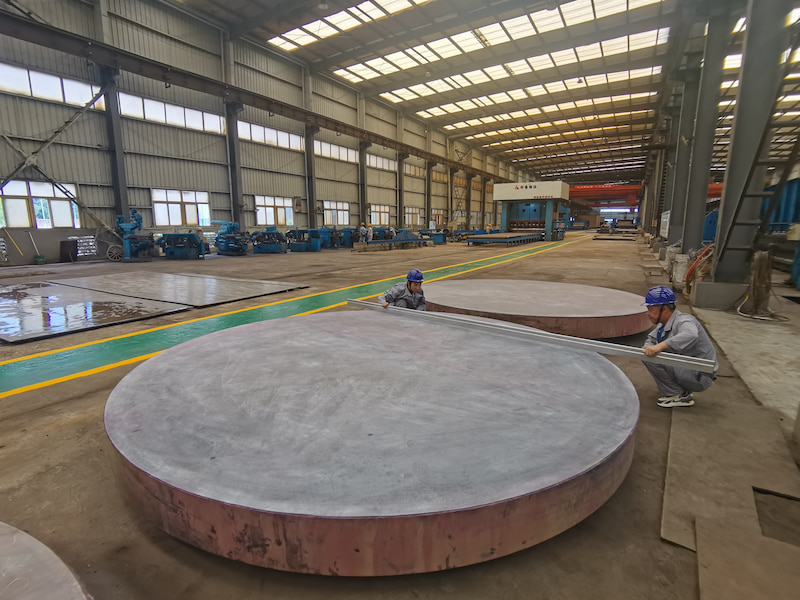Pushing the Limits of Composite Technology: 8+450mm Ultra Thick Titanium Steel Composite Plates
Sep 02, 2025
Discover how these plates are empowering the next generation of projects in the chemical, nuclear power and offshore engineering industries. Explore the manufacturing challenges they present and the immense advantages they offer.
The demand for materials capable of withstanding extreme environments, such as high pressures and highly corrosive chemicals, as well as decades of service life, continually pushes the boundaries of manufacturing. Titanium steel composite plates have long been the gold standard for critical applications, combining titanium's corrosion resistance with steel's structural strength and cost-effectiveness.
However, as engineering projects grow in scale and ambition, the materials used to construct them must also evolve. A new generation of metal laminates is emerging in the form of ultra-thick titanium-steel composites, exemplified by 8 mm thick titanium layers over 450 mm thick steel backing plates.
This represents a quantum leap, not an incremental improvement. Let's examine the significance of this specification and explain why it is reshaping heavy industry.
Why such thickness? Engineering necessity:
The '8+450 mm' dimensions are not arbitrary; they directly address specific and demanding engineering challenges.
Exceptional corrosion resistance and longevity: An 8 mm pure titanium coating is extremely thick for a cladding material. This provides formidable corrosion resistance, enabling the material to withstand severe chemical erosion for 30, 40 or even 50 years without risk of failure. This is critical for applications such as:
Large chemical reactors: Their walls must withstand high pressure and temperature while resisting highly corrosive substances such as acids and chlorides.
Flue gas desulfurisation (FGD) systems in major power stations: These systems handle large volumes of abrasive and corrosive slurries.
Exceptional structural integrity: 450 mm carbon steel bac king provides the immense mechanical strength required.
Nuclear power plant components: Pressure vessels, reactor internals and containment systems, in which wall thickness is critical for safety, radiation shielding and withstanding immense working pressures.
High-pressure process vessels: Used in the oil and gas, petrochemical and hydroelectric industries.
Critical marine and offshore structures: Components for offshore platforms or ship hulls that are subjected to extreme ocean forces.
Manufacturing marvels: How is this achieved?
Producing composite plates of such thickness is an advanced engineering feat. The most common and effective method is explosive welding.
Explosive welding (EW): This process involves placing a titanium plate (the 'composite plate') parallel to a thick steel plate (the 'backing material'). A precisely calculated explosive charge is placed on top of the titanium plate. Upon detonation, the explosive energy propels the titanium plate through the gap and strikes the steel surface at an extreme velocity and angle.
This impact generates a jet stream that cleans and presses the surfaces together under immense pressure, forming an atomic-level metallurgical bond.
This creates a unique wavy interface that ensures a strong, durable connection without compromising the properties of either metal.
Overcoming the challenge: bonding steel plates of this thickness requires precise control of explosive energy. Too little energy will fail to form a bond across the entire interface, while too much could damage the materials. Accelerating the 8 mm-thick titanium layer also demands immense energy to achieve uniform bonding. This process requires complex computer modelling and decades of specialised expertise.
Key advantages of this ultra-thick composite plate:
Cost-effectiveness: It delivers performance comparable to pure titanium at a fraction of the cost, yielding significant savings on materials for large-scale projects.
Reliability: The explosion welding process creates a permanent, 100% metallurgical bond with exceptional mechanical properties, including high shear strength.
Performance optimisation: Engineers benefit from a thick, corrosion-resistant barrier on one side and an exceptionally robust structural material on the other.
Design flexibility: Despite their large size, the plates can be formed, welded using specialised techniques, and machined into final components, offering tremendous freedom when designing large structures.
Redefining Applications:
The arrival of reliably produced, ultra-thick composite plates opens up new possibilities:
Next-generation nuclear reactors: (e.g. small modular reactors (SMRs) and fusion reactors).
Giant chemical processes for large power plants;
High-pressure, high-temperature (HPHT) subsea equipment for deep-sea oil and gas extraction;
Specialised heavy machinery for mining and metallurgy.
Layers upon layers, building the future together.
The 8+450 mm titanium steel clad plate is more than just a piece of metal; it embodies the ingenuity of the human race in the field of materials science. It demonstrates our capacity to overcome the world's most challenging engineering obstacles by combining the ideal properties of various materials in a creative manner.
As industries continually pursue larger, safer and more efficient solutions, these ultra thick composites will become the true pillars of our planet's most critical infrastructure.

 Network Supported
Network Supported